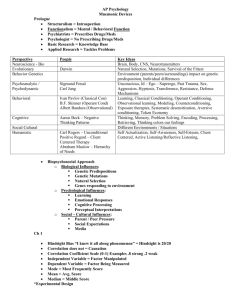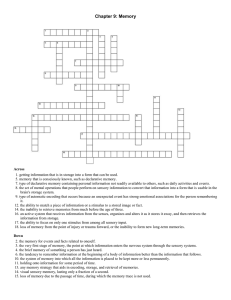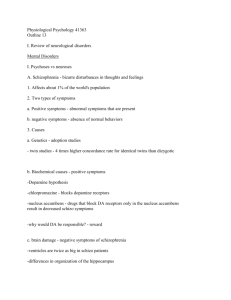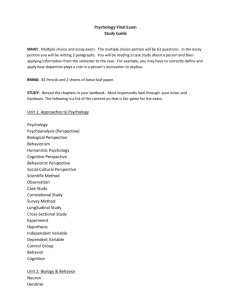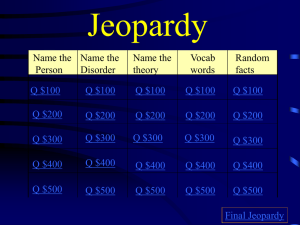encompassing guide
advertisement
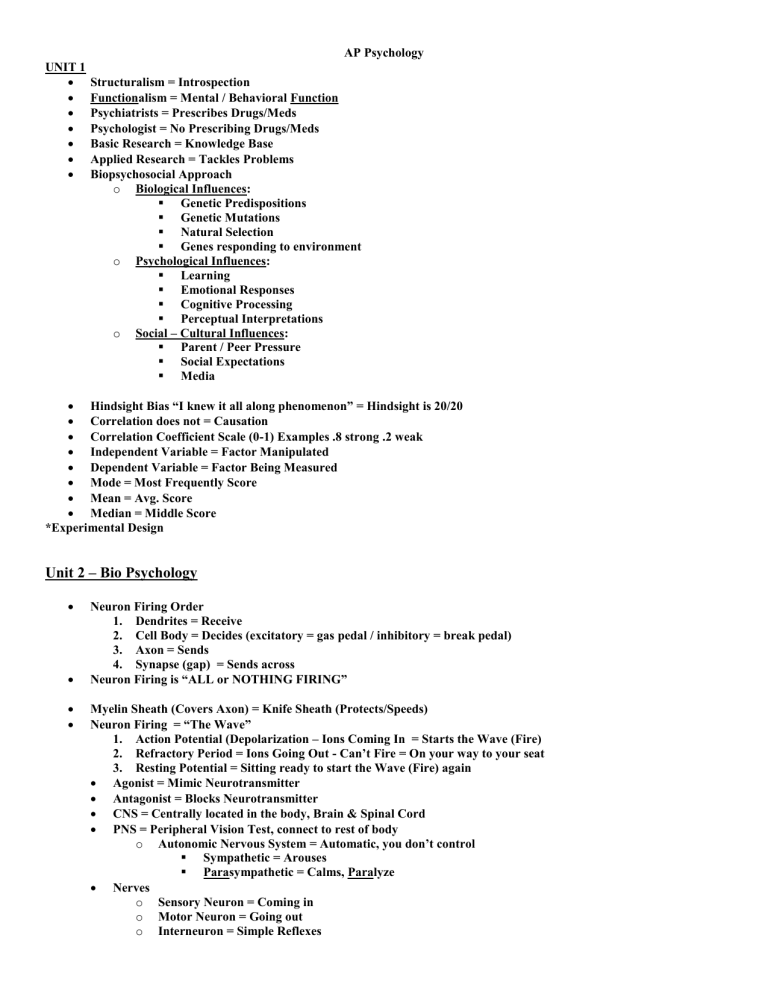
AP Psychology UNIT 1 Structuralism = Introspection Functionalism = Mental / Behavioral Function Psychiatrists = Prescribes Drugs/Meds Psychologist = No Prescribing Drugs/Meds Basic Research = Knowledge Base Applied Research = Tackles Problems Biopsychosocial Approach o Biological Influences: Genetic Predispositions Genetic Mutations Natural Selection Genes responding to environment o Psychological Influences: Learning Emotional Responses Cognitive Processing Perceptual Interpretations o Social – Cultural Influences: Parent / Peer Pressure Social Expectations Media Hindsight Bias “I knew it all along phenomenon” = Hindsight is 20/20 Correlation does not = Causation Correlation Coefficient Scale (0-1) Examples .8 strong .2 weak Independent Variable = Factor Manipulated Dependent Variable = Factor Being Measured Mode = Most Frequently Score Mean = Avg. Score Median = Middle Score *Experimental Design Unit 2 – Bio Psychology Neuron Firing Order 1. Dendrites = Receive 2. Cell Body = Decides (excitatory = gas pedal / inhibitory = break pedal) 3. Axon = Sends 4. Synapse (gap) = Sends across Neuron Firing is “ALL or NOTHING FIRING” Myelin Sheath (Covers Axon) = Knife Sheath (Protects/Speeds) Neuron Firing = “The Wave” 1. Action Potential (Depolarization – Ions Coming In = Starts the Wave (Fire) 2. Refractory Period = Ions Going Out - Can’t Fire = On your way to your seat 3. Resting Potential = Sitting ready to start the Wave (Fire) again Agonist = Mimic Neurotransmitter Antagonist = Blocks Neurotransmitter CNS = Centrally located in the body, Brain & Spinal Cord PNS = Peripheral Vision Test, connect to rest of body o Autonomic Nervous System = Automatic, you don’t control Sympathetic = Arouses Parasympathetic = Calms, Paralyze Nerves o Sensory Neuron = Coming in o Motor Neuron = Going out o Interneuron = Simple Reflexes 2 Brain Hemispheres (Right controls Left) & (Left controls Right) o Left = Language, Speech, Math o Right = Spatial, Face recognition Motor Cortex = Motor Function (Going OUT to body) Sensory Cortex = Sensory Function (Coming IN from body) Association Areas = learning, remembering, thinking, speaking Aphasia = loss of language Broca’s Area = Speech Wernick’s Area = Comprehension Broca’s Area = Left is Language, (B before W) Broca’s Area before Wernicke’s Area = Broca’s Area Left Frontal Lobe and Wernick’s Area Left Temporal Lobe EEG = Measures Brain Waves PET = Brain Activity – Glucose fMRI & MRI = Blood Flow, See Structures – Magnetic Field Brain’s Plasticity = Brain ability to Modify functioning Endocrine = Hormones o Adrenal Glands = Adrenaline o Pituitary Glands = Growth Brain Parts/Factions = Items from home Brainstem o Medulla = breathing, heartbeat o Reticular Formation = nerve network, arousal, filter Thalamus = Operator for receiving sensory information Cerebellum = learning, memory, coordinating movement “Cerebalance” Limbic System o Hippocampus = Processes Memories o Amygdala = Fear, Emotion o Hypothalamus = Eating, Drinking, Body temp., Sex Cerebral Cortex o Frontal Lobe = Front, Master Lobe, Motor Cortex o Parietal Lobe = Sensory Cortex o Temporal Lobe = Hearing, Communication o Occipital Lobe = Vision Nature / Nurture o Nature Biology Genes o Nurture Environment Parent Peers Behavior Genetics = Nurtures impact on Nature or Environments impact on Genes Chromosomes = (46 Total) 23 Male 23 Female o X Chromosome = Female o Y Chromosome = Male (The Y in BOY makes the baby a BOY) Identical Twins = One Egg / Clones / Same Genes Fraternal Twins = Two Eggs / Different Genes Heritability = Variation / Difference among Individuals 3 Unit 3 – Sensation and Perception Sensation = Detection of Physical Energy Perception = Interpretation of Physical Energy Top-down processing = Experience / Expectations impact Bottom – Up processing = Mind (Perceptions) interprets what our senses (Sensations) detect Psychophysics = Physical Energy relates to Psychology Absolute Thresholds = minimum (smallest) stimulation detected 50% Difference Threshold = minimum (smallest) difference between two stimuli 50% Signal Detection Theory = Detect faint stimulus (Signal) amid background stimulation (noise) Experience, Expectations, Motivation, and fatigue Subliminal = Below one’s absolute threshold (conscious awareness) Sensory Adaptation = Diminished sensitivity (Senses adapt to environment) Weber’s Law = to perceive a change two stimuli must differ in constant % Vision Transduction = physical energy to neural messages Eye o Pupil = hole in the eye o Iris = Colored Muscle (pupil size) o Lens = Focuses light Accommodation = Lens change curvature o Retina = Rods and Cones o Rods = Peripheral o Cones = Color o Blind Spot = Spot on Retina - No Rods / Cones o Nearsightness = Can see Near / Can’t see Far o Farsightness = Can see Far / Can’t see Near o Fovea = Focus Color Vision o Young-Helmholtz Trichromatic (three color) Theory = Red, Green, Blue o Opponent-process theory (afterimage) = Michigan (Blue/Yellow) Christmas (Green/Red) & (Black / White) Ear o Middle Ear = hammer, anvil, stirrup (Conduction hearing loss) o Cochlea = Nerve impulses (Sensorineural hearing loss) = Cochlear Implants Pain (Gate-Control Theory) = spinal cords neurological “gate” (small nerve fibers open gate – large nerve fibers close gate) Taste & Smell = Flavor Kinesthesis = Body system for position and movement Vestibular Sense= Sense of body movement and position Perception Selective attention = Limited focus Gestalt = Organized Whole Figure Ground = Object (Figure) Surroundings (Background) Groupings = perceptual organization tendencies o Proximity = Close = Together o Similarity = Similar = Together o Continuity = Continuous o Connectedness = Two things Connected = One o Closure = Fill in Gaps Depth perception = see objects 3D Binocular Cues = 2 eyes o Retinal Disparity = Difference between eyes o Convergence = Neuromuscular cue as eye turn inward Monocular Cues = 1 eye Review Monocular Cues brochure o Relative size o Interposition o Relative clarity 4 o Texture Gradient o Relative height Phi Phenomenon = motion (blinking lights) Perceptual Constancy = Unchanging / Constant (light, shape, color) Perceptual Set = Mental Set to see one thing and not another Unit 4 – Learning – A relatively permanent change in an organism’s behavior due to experience. Watson and Behaviorism – Psychology should be observable. “Observe these behaviors, Watson!” (Think Sherlock Holmes) Classical Conditioning – What goes with what – Pavlov and his puppies o UCS – Stimulus that unconditionally and naturally triggers a response (food in mouth of doggy). o UCR – Unlearned, naturally occurring response to the UCS (Salivation to food) o CS – Originally irrelevant stimulus that, after association with UCS, comes to trigger a conditioned response (Tone of tuning fork). o CR – Learned response to previously neutral stimulus (salivation to tone of tuning fork) o Acquisition – 1st stage in classical conditioning – associating a neutral stimulus (tuning fork) with an unconditioned stimulus (food) so the neutral stimulus can become the conditioned stimulus. Pavlov’s dog is acquiring the association/conditioning we desire. Pairing of two must, in most cases, be within ½ second of each other (neutral stimulus first, then UCS). o Extinction – Weakened conditioned response. Occurs when UCS (food) doesn’t follow (is extinct from) CS (tuning fork). o Spontaneous Recovery – Recovering the Conditioned Response (salivating to the tuning fork) after giving the subject a little break…the break being, of course, extinction. Spontaneous = Instantaneous REAPPEARANCE of the response after it is thought to have been extinct. o Generalization – Having the dog salivate to any sound…a general sound. o Discrimination – Having the dog salivate to a specific sound…the tuning fork. The dog is an elitist and will only salivate to an exclusive sound the tuning fork. “Any other sound is not worthy of my saliva.” Operant Conditioning – How to get what you want – Skinner and his pigeons o Respondent Behavior – A natural, automatic response/behavior to a stimulus. o Operant Behavior – Every operation/behavior has a consequence. “Every action in this world will bear a consequence.” o Law of Effect – Thorndike’s Law – If I give you some chocolate, you’ll do it more often. If I prick you with a thorn, you’ll do it less often. o Operant Chamber/Skinner Box – Animal presses a bar or key to get food/rewards. o Shaping – Reinforcing behavior to become more and more in line with an end-goal behavior. A bit like the Foot-in-the-Door Phenomenon…if you want to teach your dog to make you breakfast, you first reward him for opening the fridge, then only reward him if he opens the fridge and gets out the eggs, then only if he opens the fridge, gets out the eggs, and cooks them, and so on and so on until finally he makes you an entire breakfast! Put together little requests/tasks until you’ve shaped the subject’s behavior to what you desire in its entirety. o Reinforcer – Anything that makes someone/thing want to do something more. A pleasurable consequence. Primary reinforcer – Food (some biological need) Conditioned/Secondary reinforcer – Good grades, encouragement, money (G for grades, E for encouragement, M for money spells GEMs, which are things that are desired but not necessary for survival) o Continuous Reinforcement vs. Partial/Intermittent Reinforcement Continuous = Faster acquisition, much weaker response/easier extinction Partial = Slower acquisition of response, but much stronger response/tougher extinction o Fixed-ratio schedules – Getting a paycheck every time you sell 10 cars. o Variable-ratio schedules – Getting a paycheck whenever the lazy payroll director feels like writing one, regardless of how many cars you’ve sold. KEY TO “RATIO” SCHEDULES – # OF RESPONSES o Fixed-interval schedules – Getting a paycheck every 2 weeks…constantly checking the mail to see if the check has come yet. o Variable-interval schedules – Having a pop quiz every now and then to make sure students are studying. KEY TO “INTERVAL” SCHEDULES – AMOUNT OF TIME o Punishment – a consequence the decreases the behavior it follows = swearing and getting slapped. 5 Dangers of Punishment: Punishment not forgotten Increase subject/child aggressiveness by experimenter/parent modeling that aggression is OK. Punishment sometimes teaches subjects/children only how to get away with an act/how to avoid punishment. Punishment tells you what not to do, while reinforcement tells you what to do. Need a mix of both to be effective. o Cognitive Maps = Mental Representations o Latent Learning – Someone has learned how to run through the corn field maze through walking aimlessly, but will only be motivated to run through it and prove he/she’s learned if there’s money at the end of the maze. Latent Learning has the word Late in it…learning that only shows up later when proving what’s been learned will bring on reinforcement. o Overjustification Effect = Over-rewarding someone/something for something they already like doing. If a student intrinsically pushes him/herself to get all A’s, paying him/her $1000 for every A may cause the student to lose intrinsic motivation and do it “only for the money”. Alex Rodriguez going to play for the Texas Rangers for $252 million and saying, “It’s not about the money.” Yeah, ok Alex, you realize you are now playing baseball for the Texas Rangers, right? (Playing baseball for $ rather than for love). Observational Learning – Watching others and imitating them. Modeling –Watching others and imitating a specific behavior. Bandura and the BoBo doll – Children modeling aggressive behavior towards a blow-up doll. Prosocial Behavior – positive, constructive, helpful behavior. o Prosocial and Positive both start with a P. We imitate those around us based on whether we see them as rewarded or punished for the behavior in question. Unit Development Continuity vs. Stages Stability vs. Change Zygote = Z looks like a 2 (conception to 2 weeks) Embryo = 2nd Letter M (2 weeks to 2 Months) Fetus = Fetal Position (2 Months to Birth) Teratogens = Terrorize the Fetus w/ viruses Schemas = Concepts o Assimilate = Interpret them similarly. o Accommodate = “Make Accommodations”, Adjust / Change Interpretation Object Permanence = 8m. Objects are Permanent (Out of Sight Not Out of Mind) Conservation = 7yr. Mass (amount) is conserved even if shape is changed Egocentrism = Centralized Ego Primary Sex Characteristics = Reproduction (Genitals) Secondary Sex Characteristics = Non Reproduction (Breasts / Hair) Cross Sectional Studies = Across Various Ages (Different People) Longitudinally Studies = Over a Long Time (Same People) Piaget’s Cognitive Stages Kohlberg’s Moral Stages 6 Erickson’s Social Stages Unit States of Consciousness Consciousness = Awareness of ourselves Circadian Rhythm = biological clock 24-hour cycle Sleep Stages Awake, relaxed Stage 1 Stage 2 Stage 3 Stage 4 REM Alpha Waves Hallucinations Spindle Waves (Second = Spindles) Delta Waves (Deep Sleep) Night Terror, Sleep Walking / Wetting Rapid Eye Movement, Active Sleep, Dream, Paradoxical Sleep (Paralyzed), REM rebound = REM increase after REM deprivation Insomnia = Can’t Sleep Narcolepsy = Uncontrollable sleep attack Sleep Apnea = Stop breathing during sleep Night Terrors = Terrified during sleep, seldom remembered (stage 4) Dreams Latent (Hidden) Content – Dreams Manifest (Apparent) Content - Freud Hypnosis = State of heightened suggestibility – More suggestible = More Hypnotizable o Posthypnotic suggestion = Suggestion during hypnosis to be carried out after hypnosis o Dissociation = split in consciousness Psychoactive drug = substance that alters perception and mood Tolerance = Need more for same effect Withdrawal = Discomfort from stopping use Addiction = Craving Depressants = Alcohol, Barbiturates, Tranquilizers, Opiates Stimulants = Amphetamines, methamphetamine, Cocaine, Ecstasy Hallucinogens = LSD, Marijuana Unit 5 - Memory: Any indication that learning has persisted over time. Flashbulb Memories = Clarity of memories of surprising, significant events. o Clarity of memory of where you were on 9/11; Princess Diana’s death, etc. Encoding: Information going into our brains. Encoding = Enter. Storage: Retaining that information. Storage = Information Stays. Retrieval: Getting information back out. Three-Stage Processing model of memory: 1. Record to-be remembered information as sensory memory. 2. Process sensory memory into short-term memory, where it’s encoded for… 3. Long-term memory, from where memories are later retrieved. Working Memory: Limited. Similar to short-term memory. Includes visual and verbal components. Automatic Processing: Unconscious encoding of familiar information, such as your route while driving home. Effortful Processing: Conscious effort, such as studying these concepts and terms! In order to do it, you need to focus and pay attention. Rehearsal: Method used to boost our ability to recall different information, such as people’s names. Rehearsal = Repetition = Remembering. 7 The Next-in-Line Effect: In a line or circle of people, we remember the information presented by the person immediately before us because we’re so focused on our own performance. Spacing Effect: We retain information better if it is presented over time…so don’t cram!! Serial position effect: In memorizing a list, we remember the first and last items easiest. Three Ways of Encoding: o Meaning: We remember stuff so much better if it relates to us…self-reference effect. Semantic Encoding: Encoding of meaning, including meaning of words. Acoustic Encoding: Encoding of sounds, like words. Visual Encoding: Encoding of picture images. o Visualization/Imagery: mental pictures Often recall the times of most enjoyment far better than the mundane moments = Rosy Retrospection (It’s all roses) IE = Remembering a past relationship as far more enjoyable than it actually was. Mnemonic Devices: Imagery that aids recall, such as HOMES for the Great Lakes, or peg-words, such as one-bun, two-shoe, three-tree, etc. (See notes on other types). o Mentally organizing information for encoding Chunking: Chunk information into meaningful units/parts/chunks. Hierarchies: Organizing information by groups based on divisions and subdivisions of narrower concepts and facts. IE = Taking notes in outline form…the organization of this review sheet! Sensory Memory o Iconic Memory: Momentary sensory memory of visual stimuli, such as a slide of a tub of popcorn being “subliminally” placed in the middle of a film at the movies. o Echoic Memory: Momentary sensory memory of auditory stimuli. Sometimes you ask, “What did you say?” just as you hear in your mind the echo of what was said. Short-Term Memory = can remember seven, plus or minus two. Long-Term Memory = Unlimited Memories are not stored in single, specific spots. Long-term potentiation = prolonged strengthening of neural firing provides neural basis for memory…as you become more and more familiar with things/information, it takes less and less to have an action potential and process the information, which means you learn/remember easier. Arousal = Increased learning and retention. o It sears events into the brain. Implicit Memory: retention without conscious recollection…also called procedural memory. o Learning how to do something. Explicit Memory: memory of facts and experiences that one can consciously know and “declare”…also called declarative memory. o Declaring/knowing that you know how to do something. Hippocampus = in limbic system = helps process explicit memories for storage. o “A hippo never forgets.” Recall = a fill in the blank question on a test Recognition = a multiple choice question on a test Priming = activation of associations in memory. o Hearing the word rabbit and spelling the word hair/hare as h-a-r-e. What is the role of context in memory? It’s easier to remember things when you are in an identical or similar mood to the mood you were in when you first learned. o Mood-congruent memory Proactive Interference = prior learning interferes with recall of new information. Retroactive Interference = new learning gets in the way of old information. Misinformation Effect = our tendency to include false information in our memory of events. Source amnesia = attributing to the wrong source an event we have experienced, heard, read, or imagined. o Austin saying, “Ben said _____,” when really it was Tim who said _____. Are memories brought out through hypnosis reliable? 8 Unit Thinking (Cognition) and Language Concepts: Mental groupings of similar objects, events, and people. o Chair can be a high chair, car chair, reclining chair, etc. Hierarchies Prototypes = A mental image or best example that incorporates all the features we associate with a category. o Which is the birdier bird, a goose or a robin (which comes to mind as a bird first)? Algorithms and Heuristics Insight = “It all makes sense now!” The light bulb flashes on. Confirmation Bias = Search for information that will confirm my perceptions. Fixation Mental Set = Solve a problem using a method that has used before. Then you start to approach all similar problems the same way. Functional Fixedness = Needing to turn a screw, an individual ransacks a house when using a dime to turn the screw would’ve worked fine. Representative Heuristic = Judging the likelihood of things in terms of how well they seem to represent certain prototypes. o A person is short, slim, and likes reading poetry…is this person a truck driver or Ivy League professor? Availability Heuristic = Plane crashes seem far more frequent, as do terrorist attacks, because the memory of them is far more available than the memory of successful flights and foiled terrorist attacks. Overconfidence = Eagerness to confirm beliefs we have + knack for explaining away our failures. Framing = How we present an issue…we frame it to fit. Belief Perseverance = Cling to our beliefs even in the face of contradictory evidence. Phoneme = In spoken language, the smallest distinctive sound. Morpheme = In a language, the smallest unit that carries meaning; may be a word or part of a word (such as a prefix). o Pre-, un-, bat Grammar = system of rules (called semantics and syntax) that enables us to communicate with and understand others. o Semantics = Rules that tell how to get meaning out of morphemes, words, and sentences, such as adding –ed to laugh means it happened in the past. o Syntax = Rules used to put words in sentences in the correct orders. Babbling Stage = 4 months of age, babies babble, and babbling resembles no specific language. Babbling is babbling. One-word stage = 1-2 years, child speaks mostly in single words. Two-word stage = Beginning around 2 years old, child speaks mostly two-word statements. o Called Telegraphic Speech = Send Money. Me Hungry. (like a telegram). Thinking affects our language, which then affects our thought = two-way street/interaction between thinking and language. Intelligence Intelligence Tests = Tests for assessing a person’s mental abilities and comparing them to others’ abilities using numerical scores. Unit 6- Motivation – A need or desire that serves to energize behavior and to direct it toward a goal. Instinct = Complex behavior that is rigidly patterned throughout a species, and is unlearned. Drive-Reduction Theory = Physiological need creates aroused tension state (drive) that motivates an organism to satisfy the need. o Need (food, water) Drive (hunger, thirst) Drive-reducing behaviors (eating, drinking). Incentives = positive or negative stimuli that lure or repel us. Hierarchy of Needs = Maslow’s pyramid!!! Glucose = Sugar that circulates in the blood and supplies energy. Increases in insulin hormone diminish blood glucose, and with decreased blood glucose comes hunger. o Brain monitors this, as signals from stomach, intestines, and liver signal the brain to motivate eating or not eating. Lateral Hypothalamus = Brings on hunger. Ventromedial Hypothalamus = Depresses hunger. To estimate body fat, hypothalamus monitors leptin, a protein produced by bloated fat cells. o Leptin levels rise = brain curbs eating and increases activity. Set Point = A set weight where if the body’s weight falls below this, it triggers hunger…if it goes above it, it triggers to stop eating or not start at all. o Like a weight “thermostat” Basal Metabolic Rate = Rate of energy expenditure in maintaining basic body functions when body is at rest (for example, during sleep). 9 External Incentives and Hunger = Eating because of the mere presence of food. Anorexia Nervosa = normal-weight person diets and becomes at least 15% underweight yet still feels fat and continues to starve. Bulimia Nervosa = Overeating + vomiting, laxative use, fasting, or excessive exercise. Sexual Response Cycle = Four stages of sexual responding described by Masters and Johnson – excitement, plateau, orgasm, and resolution (know these). Refractory Period = Resting period after orgasm during which a man cannot achieve another orgasm. Estrogen = Sex hormone secreted in greater amounts in females. Hormones influence sexual arousal via the hypothalamus, which monitors both variations in blood hormone levels and activates appropriate neural circuits. Sexual Disorder = Consistently impairs sexual arousal or functioning. Physiological readiness, Imaginative stimuli, and External stimuli all lead to sexual motivation. Most psychologists now believe that nature, more than nurture, predisposes sexual orientation. Achievement Motivation = Desire for significant accomplishments; for mastery of things, people, or ideas; for attaining a high standard. High achievement motivation is tied to emotional and cognitive roots. o Associate achievement with positive emotions. o Attribute achievement to own competence and effort, which raises expectations. Intrinsic Motivation = Inside Extrinsic Motivation = Perform to gain reward or avoid punishment. Industrial/Organization (I/O) Psychology = Studies and advises on workplace behavior. How to motivate, boost morale and productivity, and design products. o Provide tasks that challenge and trigger curiosity. o Avoid snuffing out people’s sense of self-determination with overuse of extrinsic rewards. o Reward people informatively = Informing someone that his grades are really paying off, and we should celebrate that! is different, and better, than simply giving someone $5 for each A in school. Better to praise people for effort than ability. Task Leadership = Goal-oriented leadership that sets standards, organizes work, and focuses attention on goals. Tasks over people! Social Leadership = Group-oriented leadership that builds teamwork, mediates conflict, and offers support. People over tasks! Theory X = Assumes workers are basically lazy, error-prone, and extrinsically motivated by money and, thus, should be directed from above. EXTRINSIC MOTIVATION. Theory Y = Assumes that, given challenge and freedom, workers are motivated to achieve self-esteem and to demonstrate competence and creativity. INTRINSIC MOTIVATION. Emotion Emotions: Mix of physiological activation (i.e. heart pounding), expressive behaviors (i.e. quickened pace), and conscious experience (i.e. interpreting the person’s intent and feeling fearful). James-Lange Theory o Sight of oncoming car (perception of stimulus) o Pounding heart (arousal) o Fear (emotion) Cannon-Bard Theory o Sight of oncoming car (perception of stimulus) o Pounding heart (arousal) and Fear (emotion) Schachter’s Two-Factor Theory (emotions have 2 ingredients…physical arousal and a cognitive label (2 factor = 2 ingredients) o Sight of oncoming car (perception of stimulus) o Pounding heart (arousal) and Cognitive Label (I’m Afraid) o Fear (emotion) Emotion physically arouses you. o Autonomic nervous system controls arousal. Sympathetic activates arousal by directing adrenal glands atop kidneys to release stress hormones epinephrine (adrenaline) and norepinephrine (noradrenaline). Increases heart rate, blood pressure, and blood-sugar levels. Parasympathetic becomes active when crisis passes and calms body. Easy tasks = higher arousal facilitates better performance. Tough tasks = lower arousal facilitates better performance. 10 Women are better at reading people’s emotional cues. Gestures vary from culture to culture. o However, many cultures and languages share many similarities in the ways they categorize emotions – anger, fear, etc. Emotions o Fear: Prepares bodies to flee danger. Triggers emotion of worry. Can learn to fear, especially by observation. Nature and nurture. Fear some items biologically. Key to learning lies in the amygdala. Within limbic system. Associates various emotions with certain situations. o Anger OK, unless it causes us to feel guilty or fuels aggressive acts (verbal or physical). Catharsis – Reduce anger through releasing it through aggressive action or anxious. How to handle anger: Wait…time heals. Deal with it in ways other than chronic anger or passivity…exercise, play instrument, etc. o Happiness One’s state of happiness or unhappiness colors everything we do. Attitude is everything! Bad moods make the whole world look gloomy, and the opposite is true about good moods! Feel-Good, Do-Good Phenomenon: Happy people are more likely to help others. Subjective Well-Being – Self-perceived happiness or satisfaction with life. People have an undeniable ability to cope and find happiness in life’s circumstances. Bad break-ups Accidents (Christopher Reeve) Adaptation-Level Phenomenon – Our tendency to form judgments (of sounds, lights, income, whatever) relative to a “neutral” level defined by our prior experience. o EVERYTHING IS RELATIVE o If our current condition, such as our income, goes way up, we’ll initially feel a surge of pleasure, but then “get used to it”. Relative Deprivation – The perception that one is worse off relative to those with whom the individual compares himself. o LeBron James thinking himself poor because he’s only looking at Bill Gates and Ted Turner. o Latrell Sprewell, NBA Basketball Player, saying he needs to make $8 million/year because he “has to put food on the table for his family.” Predictors of happiness: o Engaging in challenging activities, especially if it does not cost a lot!!! o Sleep well o Meaningful, religious faith o Close friends and satisfying marriage o High self-esteem Unit 7 - Personality: Your characteristic pattern of thinking, feeling, and acting. Free Association Psychoanalysis Unconscious Preconscious – Information not conscious but retrievable into conscious awareness. Id – Devil on shoulder. Ego – Compromise – Your head in the middle of the devil and angel argument. Superego – Angel on shoulder. Psychosexual Stages o Oral Stage (0-18 months) = Pleasure centers on the mouth – sucking, biting, chewing o Anal Stage (18-36 months) = Pleasure focuses on bowel and bladder elimination; coping with demands for control. o Phallic Stage (3-6 years) = Pleasure zone is the genitals; coping with incestuous sexual feelings. Oedipus Complex Identification Process = Process of incorporating child’s parents’ values with own developing superegos. o Latency Stage (6-puberty) = Dormant Sexual Feelings. o Genital Stage (puberty on) = Maturation of sexual interests. 11 Fixation = A lingering focus of pleasure-seeking energies at an earlier psychosexual stage, where conflicts were unresolved. o Fixation at oral stage may be seen through smoking and/or eating. Defense Mechanisms o Repression – Banishing anxiety-arousing thoughts, feeling, and/or memories from consciousness. o Regression – Anxiety causes someone to act in a manner consistent with earlier psychosexual stage, such as being afraid and curling up into the fetal position. o Reaction Formation – Hating someone and acting, because hate is unacceptable, like you love that person instead. Like with a boss. o Projection – “You want her/him, don’t you,” when really it’s you who want her/him. o Rationalization – Self-justification as to why eating cotton candy can actually be healthy. o Displacement – Boss yells at you, you kick the dog. o Sublimation – Aggressive person plays football and turns unacceptable impulses into socially valued skills. Projective Tests – Ambiguous stimuli presented for an individual to create a story about it…Rorschach Tests, etc. Thematic Apperception Test (TAT) – People view ambiguous pictures and make up stories about them. Neo-Freudians – Put more emphasis on the role of the conscious mind both in interpreting experience and in coping with the environment. o Also thought sex and aggression were all-consuming motivations, so put more emphasis on social interaction. Karen Horney Carl Jung o Collective Unconscious Trait Perspective of Personality o Describe people in terms of their characteristic behaviors and conscious motives. Big Five Personality Factors (CANOE, OCEAN) Minnesota Multiphasic Personality Inventory (MMPI) – Originally focused on emotional disorders, this now is most widely used personality test. Maslow Self-actualization Unconditional Positive Regard Self-concept – “Who am I?” Self-esteem – One’s feelings of high or low self-worth. Self-Serving Bias – Perceive oneself favorably. Individualism vs. Collectivism o Characteristics of each type of living and the individuals who live this life-style. Social-Cognitive Personality Theory Reciprocal Determinism – Interacting (back and forth) influences between personality and environmental factors. Personal Control – External vs. Internal Locus of Control Learned Helplessness – Hopelessness and passive resignation of an animal or human when unable to avoid repeated aversive (negative) events. Positive Psychology – The scientific study of optimal human functioning; aims to discover and promote conditions that enable individuals and communities to thrive. Unit 9 - Psychological Disorders Disorder – Harmful, atypical, disturbing, maladaptive, and unjustifiable. Medical Model – Concept that diseases have physical causes that can be diagnosed, treated, and, in most cases, cured. Bio-psycho-social perspective – biological, psychological, sociocultural factors combine to produce psychological disorders. DSM-IV – Classifies disorders Neurotic Disorder – Distressing disorder that allows one to still think rationally and function socially. o Freud thought of theses as ways of dealing with anxiety. Psychotic Disorder – Person loses contact with reality, experiencing irrational ideas and distorted perceptions. o Classic example of a “psycho” with a psychotic disorder. Issues with labeling disorders, and therefore people… Anxiety Disorder – Distressing, persistent anxiety or maladaptive behaviors aimed at reducing anxiety. o Generalized Anxiety Disorder – A general case/sense of anxiety. o Panic Disorder – Person experiences terror and chest pain, choking, or other frightening sensations. o Phobia – Persistent, irrational fear and avoidance of specific object or situation. 12 OCD – Unwanted thoughts (obsessions) and/or actions (compulsions). Bad when interfere with the way we live or when they cause distress. o Explanations for Anxiety Disorders Learning Perspective Stimulus Generalization Reinforcement Observational Learning Biological Perspective Evolution Mood Disorders – Psychological disorders characterized by emotional extremes. o Dysthymic Disorder – State between blue moods and depression. Most days filled with down-in-the-dumps mood for 2 years or more. Chronic low energy and self esteem Difficulty making decisions and concentrating Sleep and eat too much or too little o Major Depressive Disorder – Signs of depression last 2 weeks or more. #1 reason why people seek mental health services. o Manic Episode – Hyperactive, wildly optimistic state. o Bipolar Disorder – Alternates between hopelessness and lethargy of depression and overexcited state of mania. o Facts: Depression is widespread. Behavioral and cognitive changes go hand-in-hand with depression. Women 2x more likely to experience major depression. Most major depressive episodes last less than 6 months. Stressful events often precede depression. With each generation the rate of depression increases and strikes at earlier ages. o Explanations for Mood Disorders Biological Perspective Genetic o Parent/sibling with depression before age 30 = higher risk Brain o Norepinephrine = over-abundant in mania, scarce in depression. o Serotonin = scarce during depression Social-Cognitive Perspective Pessimism, self-defeating beliefs Learned helplessness Attributions of blame for life’s issues o Depressed people’s attributions are: Stable – It’s going to last forever Global – It’s going to affect everything I do Negative Thoughts feed Negative Moods o Negative thinkers are vulnerable to depression. Negative Moods feed Negative Thoughts o People with negative moods are vulnerable to depression. Depression’s Cycle o Self-blame and self-focused responses to bad events = depression, possibly over and over again. o 1. Negative, stressful events interpreted through, 2. a ruminating, pessimistic explanatory style create, 3. a hopeless, depressed state that, 4. hampers the way the person thinks and acts. o This, in turn, fuels more negative experiences, and the cycle continues. Dissociative Disorders – Person appears to experience a sudden loss of memory or change in identity. o Dissociative Identity Disorder (DID) – 2 or more distinct identities that alternately control the person’s behavior. Schizophrenia – SPLIT MIND – Group of severe disorders characterized by disorganized and delusional thinking, disturbed perceptions, and inappropriate emotions and actions. Delusions – False beliefs o “I’m Mary Poppins!!” o Delusions of persecution o 13 o Delusions of grandeur “I’m Jesus Christ!” “I’m Ghandi!” “I’m Allah!” Hallucinations – Sensory experiences without sensory stimulation (usually auditory). o Hearing voices… Show inappropriate emotions. Catatonia – Motionless for hours on end…in the same position. Social relationships very difficult. Positive Symptoms – Symptoms that are present that should not be there. o Their presence is positively present. o Presence of inappropriate behaviors. Negative Symptoms – Absence of appropriate behaviors. Types of Schizophrenia o Paranoid – Preoccupation with delusions or hallucinations. “Alien abductions!!! AHHHH!!!! I’m so paranoid!!!” o Disorganized – Disorganized speech or behavior, or flat or inappropriate emotion. o Catatonic – Immobility (or excessive, meaningless movement), extreme negativism, and/or parrotlike repeating of another’s speech or movements. o Undifferentiated – Many and varied symptoms. Undifferentiated = many different symptoms o Residual – Withdrawal, after hallucinations and delusions have disappeared. All that is left is the residue of old Schizophrenia. Brain Abnormalities in Schizophrenia o Dopamine Overactivity o Low activity in frontal lobes, shrunken hippocampus and amygdale in the limbic system. o Small thalamus Personality Disorders – Inflexible and enduring behavior patterns that impair social functioning. Types: Some express anxiety, some have eccentric behaviors, others dramatic or impulsive behaviors. Antisocial Personality Disorder – Usually affects men. Lack of conscience for wrongdoing, even toward friends and family members. May be aggressive and ruthless or a clever con artist. o Frontal lobe damage = bad planning and judgment Therapy Psychotherapy – An emotionally charged, confiding interaction between a trained therapist and someone who suffers from psychological difficulties. o Free association o Resistance – Blocking from consciousness of anxiety-laden material. o Interpretations from therapist and insight. o Latent content o Transference – Transferring emotions from someone close to you over to your therapist. Interpersonal Therapy – Looking at current relationships and helping with relationship skills. Humanistic Therapy – Aimed at making us successful humans. o Focus on: present and future conscious thoughts taking responsibility promoting growth o Client-centered therapy o Nondirective therapy o GER/GEA Genuineness Empathy Respect/Acceptance o Active Listening Behavior Therapy – Applies learning principles to elimination of unwanted behaviors. o Counterconditioning – New responses to stimuli that trigger unwanted behaviors. Systematic Desensitization Progressive Relaxation – Relaxing one muscle after another until you’re totally relaxed. Exposure Therapy – Exposes someone, in imagination or actuality, to a feared situation. 14 Flooding – Putting Mr. Oldenbroek in the middle of a lake and leaving him there to “confront” his fear of large bodies of water…I don’t think I’d make it, by the way. Aversive Conditioning – Replace a positive response to a harmful stimulus (such as alcohol) with a negative (aversive) response. o Token Economy Cognitive Therapy – Teaches people new, more adaptive ways of thinking and acting. o Based on the assumption that thoughts intervene between events and our emotional reactions. o Seek to reverse clients’ self-defeating, catastrophizing thoughts about themselves. o Cognitive-Behavior Therapy – Aims to alter the way people act (behavior therapy) and alter the way they think (cognitive therapy).
